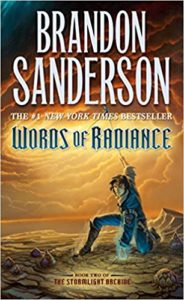This is the third of a five-part series on Mormon speculative fiction.
The Association for Mormon Letters is for writing by, for, and about Mormons, and this type of speculative fiction falls into the last category: science fiction about Mormons. Latter-day Saints show up in a surprising number of science fiction works, both those written by Mormons and not. In this post, we’ll explore why this might be and look at some of the many examples of Mormons in speculative fiction. (Obviously, there’s no way I can include every example out there, but hopefully I’ll include some interesting ones. You can share some of your favorites that I’ve missed in the comments.)
Why Mormons in Science Fiction?
Orson Scott Card’s early successes spawned critical attention from the Mormon intellectual community which began to debate the value and nature of Mormon science fiction. The first article on the subject was “Science Fiction and Mormonism: A Three-Way View” by Sandy and Joe Straubhaar in Sunstone in July/August 1981. They argued what many Mormon science fiction fans already knew: that religious questions were not only compatible with science fiction, but that “the most insistent and common themes in science fiction are unashamedly religious ones.” They went on to list six main themes of science fiction which coincide with the interests of Mormon theology:
- The identity of the human race and possibilities for human progression
- The identity of the individual and questions of destiny and free will
- Explanations for the “homesickness” of the human soul
- The identity and origin of God
- Responsibility for personal actions and the ability to atone for mistakes that affect others, and
- The ideal structure of society and the treatment of fellow beings.
I would to this list a seventh theme:
- Accounting for intelligent life on other planets and our relationship to them
Many of these themes dovetail well into the interests of science fiction writers. In 1989, Card published his Folk of the Fringe short story collection, which examines Mormonism as a power structure in a future, post-apocalyptic Utah. This theme had been dealt with in a hostile way in mainstream science fiction (for example in Dean Ing’s Systemic Shock, (1981)), but Card’s attempt presents a view that is radically Mormon as he looks into the possibilities for a future LDS theology which includes the demise of America and the rise of the Lamanites’ descendants.
There are many lesser known examples of science fiction written by and about Mormons, including the LDSF collections mentioned in the previous article. And I’ve seen plenty of speculative fiction show up in Mormon fiction contests. Overall, this is a less explored territory than we might wish.
Much more prevalent are Latter-Day Saints showing up in non-Mormon science fiction for a different, less flattering reason.
The Nauvoo and Other Starships
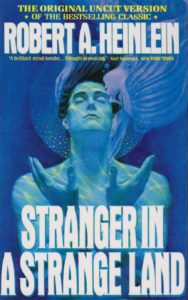 In their 1981 Sunstone article, the Straubhaars noted the disproportionate popularity of Mormons as characters in mainstream works as cult figures. Michael Collings, in his article “Refracted Visions and Future Worlds: Mormonism and Science Fiction” published in Dialogue in 1986, studied several mainstream science fiction stories with prominent references to Mormonism. The most notable was the satiric “Fosterite Church of the New Revelation” in Robert Heinlein’s Stranger in a Strange Land (1961); the sexually repressed hypocrite Nephi Sarvant in Philip Jose Farmer’s Flesh (1986); and the attempt to theologically sanitize Mormonism in Piers Anthony’s Planet of Tarot trilogy (1979).
In their 1981 Sunstone article, the Straubhaars noted the disproportionate popularity of Mormons as characters in mainstream works as cult figures. Michael Collings, in his article “Refracted Visions and Future Worlds: Mormonism and Science Fiction” published in Dialogue in 1986, studied several mainstream science fiction stories with prominent references to Mormonism. The most notable was the satiric “Fosterite Church of the New Revelation” in Robert Heinlein’s Stranger in a Strange Land (1961); the sexually repressed hypocrite Nephi Sarvant in Philip Jose Farmer’s Flesh (1986); and the attempt to theologically sanitize Mormonism in Piers Anthony’s Planet of Tarot trilogy (1979).
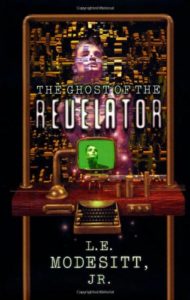 In other words, many of the Mormon stereotypes of the 19th century survived intact in genre fiction, and specifically in science fiction. The issue of the apparent antagonism of mainstream science fiction to Mormonism continues to be a concern: Greg Bear’s 1994 Nebula award-winning novel Moving Mars contains a Mormon senator as the principle antagonist, and L. E. Modesitt’s The Ghost of the Revelator (1998) portrays a hostile alternate history of the state of Deseret.
In other words, many of the Mormon stereotypes of the 19th century survived intact in genre fiction, and specifically in science fiction. The issue of the apparent antagonism of mainstream science fiction to Mormonism continues to be a concern: Greg Bear’s 1994 Nebula award-winning novel Moving Mars contains a Mormon senator as the principle antagonist, and L. E. Modesitt’s The Ghost of the Revelator (1998) portrays a hostile alternate history of the state of Deseret.
A more contemporary example of this phenomenon is the portrayal of Mormons in the Expanse novels by James S A Corey and the subsequent Syfy/Amazon show. The Mormons in the show are portrayed as stereotypes–not 19th century century stereotypes but contemporary stereotypes. In the story, the church is building a generation ship called the Nauvoo (complete with angel Moroni) in order to escape birth control laws on Earth. They are efficient, wealthy, white, overly-earnest, and perhaps a bit naive to the darker workings of the universe, especially when their ship is stolen.
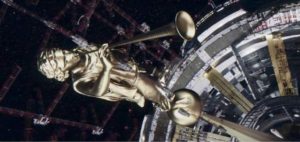 Perhaps someone will prove me wrong, as I haven’t read the novels and don’t have deep knowledge of the series, but it doesn’t seem that there are any particularly deep or thematic connections to the religion. Peggy Fletcher Stack seems to agree in her analysis of the show for the Religion News Service.
Perhaps someone will prove me wrong, as I haven’t read the novels and don’t have deep knowledge of the series, but it doesn’t seem that there are any particularly deep or thematic connections to the religion. Peggy Fletcher Stack seems to agree in her analysis of the show for the Religion News Service.
In many sci-fi works, Mormons are a handy stand-in for a wealthy, slightly cult-ish religion which could be almost any other, except that it happens to be ours. Why pick Mormons over other equally less-mainstream religions? Here are a couple of spitball interpretations that could use some more study:
- Selection bias could play a role here. I haven’t studied science fiction about other religions, so maybe the representation is only proportional. This would make an interesting Google Books study.
- Mormonism is founded on a willingness to change and adapt theology to fit science moving forward. We might be seen as a group likely to adapt to the future rather than be left behind by it, and thus still be present in the far future.
- The prevalence of our missionaries makes us familiar and yet unfamiliar at the same time, perfect for pulling into a science fiction story.
The Mormon Hat Tip
A final way that Mormons are used in science fiction is as a throw-away reference to tip the author’s religious hand to those in the know. I would include in this category some of Scott Card’s most famous Mormon references, for example, the identification of Ender’s mother as a lapsed Mormon who argues with Ender’s Catholic father over the mode of their son’s secret baptism. It’s a blink-and-you-miss-it moment, but a sly wink (if you will) from the author to the reader. Michael Collings’ 1986 Dialogue article deems these references trivial, though he notes they are sometimes demanded by Mormon readers who feel betrayed if references are left out.
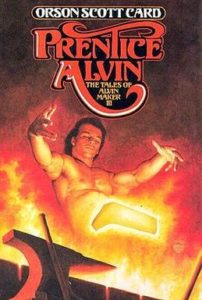 We can also include the “generalized analogs” present in Card’s work: Card’s Homecoming and Tales of Alvin Maker series borrow their plotlines directly from the Book of Mormon and Joseph Smith’s life. Collings respects these ideas as genuine explorations of Mormonism and would later write about them at length in his several biographies and papers on Card. And the original Battlestar Galactica series had many hat tips to those who knew its Mormon origins, with Kobol/Kolob just to scratch the surface.
We can also include the “generalized analogs” present in Card’s work: Card’s Homecoming and Tales of Alvin Maker series borrow their plotlines directly from the Book of Mormon and Joseph Smith’s life. Collings respects these ideas as genuine explorations of Mormonism and would later write about them at length in his several biographies and papers on Card. And the original Battlestar Galactica series had many hat tips to those who knew its Mormon origins, with Kobol/Kolob just to scratch the surface.
Each of these series certainly can be read (or watched) without knowledge of Mormon history, just as the Chronicles of Narnia are read by many children who fail to see the Christian allegory. But reading them with the appropriate background novel brings another layer of meaning to the text, letting the reader compare and contrast what happens in the real and fictional accounts.
If we can move into fantasy fiction for a moment, I have been struck by a couple of these hat tips as I read Brandon Sanderson’s work. In Words of Radiance, confirmed bachelor Adolin Kholin says in exasperation, “It is all right for Jasnah to run around in her middle thirties without a spouse, but if I reach my 23 birthday without a bride I’m some kind of menace.” This echoes a popular (possibly apocryphal) quote from Brigham Young that every BYU student hears at least once.
Similarly, Dalinar Kholin, a religious reformer figure with echoes of Joseph Smith in him, has a written account of his visions stolen and the words altered to be used against him. The parallel to the lost 116 pages jumps off the page if you are in the know. (The Millennial Star published an article with more thematic parallels from Sanderson’s work a few years back that’s worth a look. I plan to explore Mormon-ness in Sanderson’s writing in future articles, so I’ll just leave it here for now.
These hat tips are quite fun to pick out. They give readers a sense of being insiders, true fans who know the author better for their shared belief. It creates a sense of loyalty to the author. I’d wager that much of Mormon pop culture enthusiasm for Battlestar Galactica and Ender’s Game probably stem in part from these hat tips.
In the next article, we’ll move on to the most significant category of Mormon speculative fiction, that is, books written by Mormons but with no specific church references. But perhaps we might find them more Mormon than we think.
Here are some other articles on the subject of Mormons in speculative fiction:
“Mentioning Mormons in science fiction“, by Eric James Stone, Dawning of a Brighter Day, 2012.
“Mormons in Speculative Fiction“, by Edje Jeter. Juvenile Instructor, 2013.
 Liz Busby is a writer of creative non-fiction and speculative fiction. She loves reading science fiction, fantasy, history, science writing, and self help, as well as pretty much anything that holds still for long enough. Liz graduated from BYU with a BA in English, and lives in Bellevue, WA, with her husband and four kids. Follow her writing at www.lizbusby.com.
Liz Busby is a writer of creative non-fiction and speculative fiction. She loves reading science fiction, fantasy, history, science writing, and self help, as well as pretty much anything that holds still for long enough. Liz graduated from BYU with a BA in English, and lives in Bellevue, WA, with her husband and four kids. Follow her writing at www.lizbusby.com.

